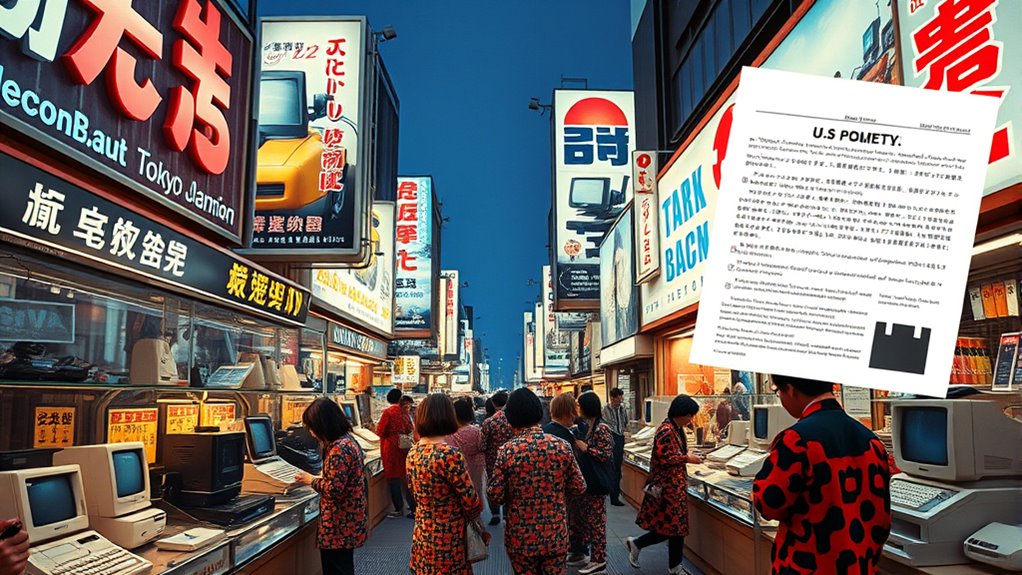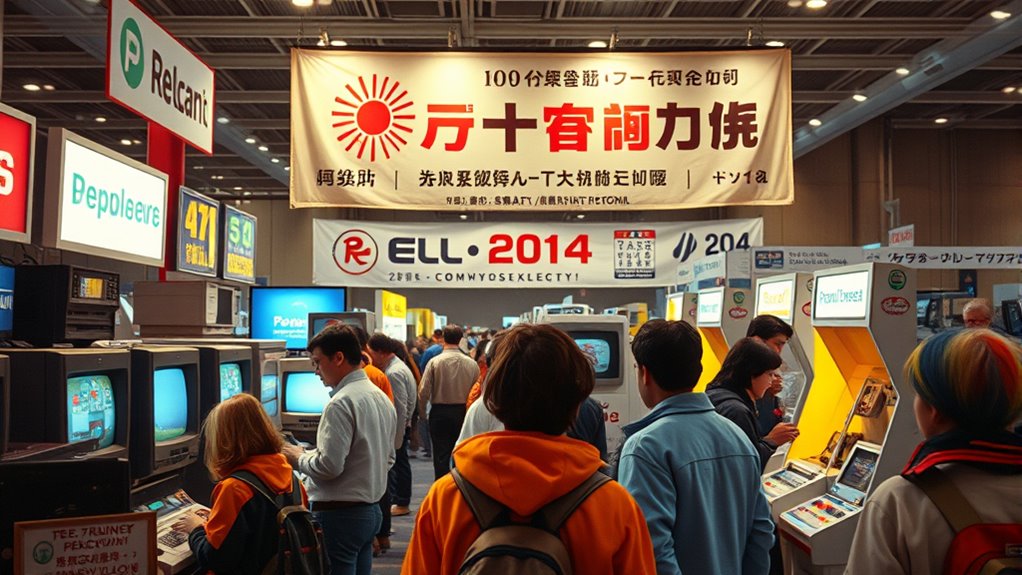In the ’80s, Japan’s rapid tech growth pushed the U.S. to rethink its innovation and trade policies. Japan focused on aggressive trade strategies, government support, and heavy R&D investments to dominate electronics, cars, and computing sectors. In response, the U.S. increased support for startups, re-evaluated trade practices, and emphasized sustainable, long-term innovation. To understand how these lessons shaped today’s strategies, exploring more will give you a clearer picture of ongoing global tech competition.
Key Takeaways
- Japan’s strategic government-industry partnerships accelerated innovation, providing a model for U.S. policy reforms to foster similar ecosystems.
- Heavy investment in R&D and protectionist policies helped Japan dominate electronics and automotive sectors, highlighting the importance of targeted support.
- The U.S. responded by increasing domestic R&D funding and supporting startups to remain competitive in global technology markets.
- Long-term innovation and sustainable growth became central to strategies, emphasizing resilience and eco-friendly technologies.
- Addressing unfair trade practices and building resilient infrastructure were crucial for maintaining technological leadership, lessons from Japan’s rise.

The 1980s marked a pivotal period when Japan’s rapid technological advancements transformed it into a global tech powerhouse, prompting the U.S. to reevaluate its policies. During this time, Japan’s rise was driven by aggressive trade strategies and forward-thinking innovation policies that allowed its companies to dominate markets worldwide. You might notice how Japan focused on building strong relationships through trade agreements, securing access to key markets, and protecting its emerging industries with strategic government support. These trade strategies weren’t just about exporting products; they aimed to create a competitive ecosystem that fostered continuous innovation. The government invested heavily in research and development, encouraging firms to push technological boundaries and develop cutting-edge products. This synergy between government initiatives and corporate pursuits propelled Japan into the forefront of electronics, automobiles, and computing technology.
Japan’s strategic trade and innovation policies propelled it to tech dominance in the 1980s, reshaping global markets.
As Japan’s tech industry expanded, it became clear to the U.S. that it needed to adapt its approach. The American response centered on reevaluating its own innovation policies and trade strategies to remain competitive. You’d see policymakers pushing for increased investment in research, emphasizing the importance of fostering a domestic environment where innovation could thrive. The U.S. government began to prioritize technology development, creating programs that supported startups and established research institutions. These efforts aimed to stimulate innovation, boost productivity, and maintain global leadership in key sectors. Additionally, the strategic use of government support to foster a competitive ecosystem proved crucial for Japan’s success, highlighting the importance of coordinated efforts between public and private sectors. Recognizing the role of government support in Japan’s success, the U.S. started exploring ways to replicate similar strategies domestically. Moreover, the integration of public-private partnerships played a significant role in Japan’s technological breakthroughs, offering a model for U.S. policymakers to consider.
Furthermore, understanding the importance of sustainable growth, the U.S. started exploring ways to balance economic expansion with environmental considerations, especially as clean energy technologies like hydrogen fuel cells gained prominence. Incorporating lessons from Japan’s emphasis on long-term innovation helped shape U.S. strategies to foster resilience and adaptability in its industries. You might also notice how the U.S. began to scrutinize trade practices more closely, aiming to address concerns about market access and unfair competition. The goal was to create a balanced playing field where American companies could compete effectively against Japanese firms. This involved negotiating trade agreements, imposing tariffs, or implementing policies designed to protect and promote U.S. industries. The strategic shift wasn’t just reactive; it was about building a resilient infrastructure that prioritized technological advancement and economic security.
In essence, the lessons from the ’80s illustrate that a combination of smart trade strategies and innovation policies can reshape a nation’s economic landscape. Japan’s success showed the importance of government support combined with private sector dynamism. The U.S. learned that to stay competitive, it needed to foster its own technological ecosystem, investing in R&D, nurturing startups, and ensuring fair trade practices. If you observe today’s tech landscape, many of these lessons still resonate—highlighting the enduring importance of strategic policymaking in maintaining technological and economic leadership.
Frequently Asked Questions
How Did Japan’s Tech Boom Influence Global Markets Beyond the 1980S?
You see, Japan’s tech boom pushed global market shifts and spurred technological innovation worldwide. It prompted other countries to invest heavily in electronics and manufacturing, leading to a surge in competition. You benefit from this by experiencing faster, more advanced gadgets and electronics. The ripple effect also encourages continuous innovation, shaping industries and consumer habits across the globe, long after the ’80s, making tech more accessible and integrated into your daily life.
What Specific U.S. Policies Were Enacted in Response to Japan’S Tech Growth?
Imagine you’re guarding your home from a fast-moving intruder. In response to Japan’s tech growth, you set up trade restrictions and tighten intellectual property protections. The U.S. enacted policies like export controls and strengthened patent laws to prevent losing ground. These measures aimed to curb Japan’s technological advances and protect American innovation, ensuring your home remains secure amid the rapidly advancing global tech landscape.
Were There Any Long-Term Consequences of the U.S. Policy Measures Taken During This Period?
You might wonder about the long-term effects of U.S. policy impacts during that era. These measures aimed to protect U.S. tech markets, but they also led to unintended consequences like stifling innovation and fueling trade tensions. Over time, these policies influenced how the U.S. approached tech competition, pushing for more open trade and innovation strategies. Overall, the long-term effects shaped future policies and international relations in tech sectors.
How Did Japanese Companies Adapt to U.S. Policy Pressures During the Tech Boom?
You see Japanese companies facing trade tensions during the tech boom, and they adapt by refining innovation strategies, diversifying markets, and strengthening alliances. They invest heavily in R&D, streamline operations, and shift focus to emerging technologies to stay competitive. This proactive approach helps them navigate U.S. policy pressures, maintain growth, and sustain their global presence despite external challenges, demonstrating resilience and strategic agility in a complex international landscape.
What Lessons From the ’80s Can Inform Current Tech and Trade Policies?
You should consider how effective market regulation and innovation strategies shaped the tech landscape today. Learning from the ’80s, you realize that balanced regulation fosters healthy competition, while encouraging innovation drives growth. By adopting flexible policies that promote technological advancement without stifling market dynamics, you can guarantee sustainable development. These lessons help craft policies that support innovation while maintaining fair market practices, ultimately strengthening your country’s position in global tech and trade arenas.
Conclusion
If you learn from Japan’s ’80s tech boom, you see history’s echo warns us not to let ambition outpace regulation. Like a tightrope walker balancing on innovation’s wire, you need steady policies to avoid a fall. By understanding this dance between growth and oversight, you can help shape a future where tech progress doesn’t leave the economy or society behind. Remember, the past is a mirror—use it wisely to keep your footing firm.








